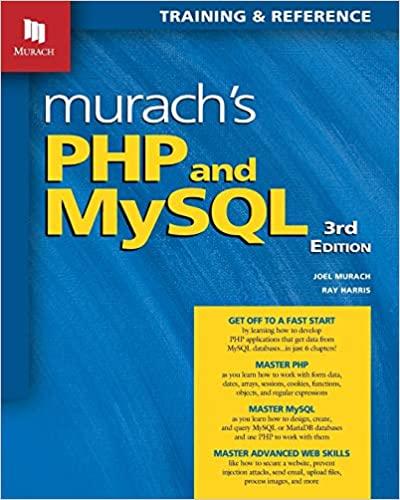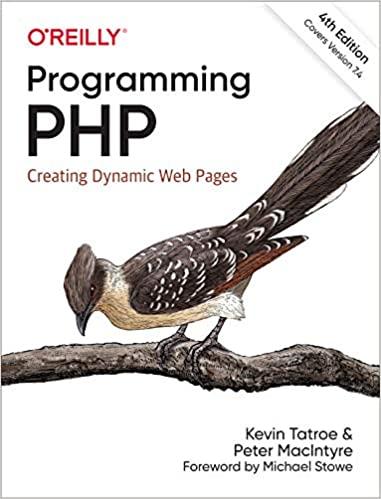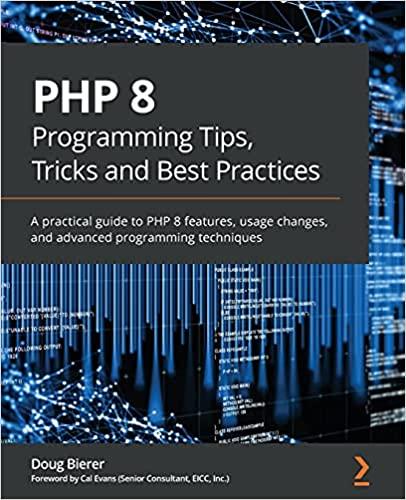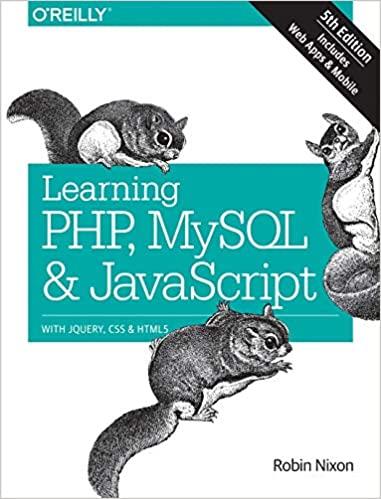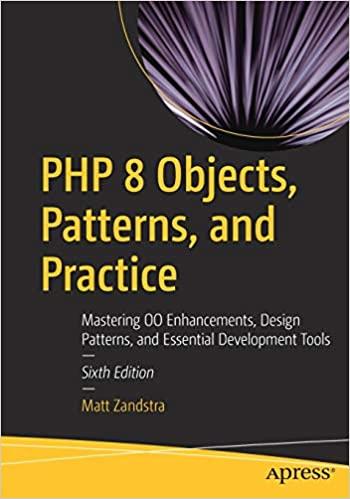React Firebase storage Upload and save url to firestore
Read More
Upload Multiple Images And Store In Database Using PHP And MySQL.
Read More
Books
Murach’s PHP and MySQL (3rd Edition)
“I can’t count how many PHP books I have purchased over the years trying to learn the language. Murach’s was the first book that helped me grasp the concepts and got me onto actually scripting in PHP.”
That’s what one developer posted on the first edition of Murach’s PHP and MySQL. Now, this 3rd Edition does a better-than-ever job of delivering the skills you need to develop database-driven websites using PHP and MySQL, the way today’s top web professionals do.
Section 1 is a quick-start course that shows how to use the latest versions of PHP, MySQL (or MariaDB), and the Apache web server to build your first PHP applications. Right from the start, you’ll learn to create applications that conform to the MVC pattern, so they’ll be easier to maintain as they grow. In addition, you’ll learn how to create applications that prevent SQL injection attacks and guard against XSS attacks.
Section 2 takes you deeper into PHP by covering the skills you’ll use every day, like how to work with form data, dates, arrays, sessions, cookies, functions, objects, regular expressions, and exceptions. Likewise, Section 3 dives into MySQL, teaching you how to design and create a database, as well as how to access and maintain database data from your PHP programs. Finally, Section 4 teaches you important web programming skills like how to secure web pages, send email, upload files, and process images.
Along the way, you’ll find out how to take advantage of PHP 7 enhancements like scalar data type declarations and improved error handling, as well as new operators and functions.
Complete sample applications and chapter exercises provide training support throughout. A great choice for any developer who wants to master PHP without a lot of frustration and unnecessary expense.
Programming PHP: Creating Dynamic Web Pages
Why is PHP the most widely used programming language on the web? This updated edition teaches everything you need to know to create effective web applications using the latest features in PHP 7.4. You’ll start with the big picture and then dive into language syntax, programming techniques, and other details, using examples that illustrate both correct usage and common idioms.
If you have a working knowledge of HTML, authors Kevin Tatroe and Peter MacIntyre provide many style tips and practical programming advice in a clear and concise manner to help you become a top-notch PHP programmer.
Understand what’s possible when you use PHP programs
Learn language fundamentals, including data types, variables, operators, and flow control statements
Explore functions, strings, arrays, and objects
Apply common web application techniques, such as form processing, data validation, session tracking, and cookies
Interact with relational databases like MySQL or NoSQL databases such as MongoDB
Generate dynamic images, create PDF files, and parse XML files
Learn secure scripts, error handling, performance tuning, and other advanced topics
Get a quick reference to PHP core functions and standard extensions
PHP 8 Programming Tips, Tricks and Best Practices: A practical guide to PHP 8 features, usage changes, and advanced programming techniques
Discover effective techniques, workarounds, and expert guidance for avoiding situations where your application might break following PHP 8 migration
Key Features
Get the hang of all the new features introduced in PHP 8
Learn how to detect potential code breaks and keep your application code running smoothly in PHP 8
Explore an exciting new trend – asynchronous PHP programming using Swoole and Fibers
Book Description
Thanks to its ease of use, PHP is a highly popular programming language used on over 78% of all web servers connected to the Internet. PHP 8 Programming Tips, Tricks, and Best Practices will help you to get up-to-speed with PHP 8 quickly. The book is intended for any PHP developer who wants to become familiar with the cool new features available in PHP 8, and covers areas where developers might experience backward compatibility issues with their existing code after a PHP 8 update. The book thoroughly explores best practices, and highlights ways in which PHP 8 enforces these practices in a much more rigorous fashion than its earlier versions.
You’ll start by exploring new PHP 8 features in the area of object-oriented programming (OOP), followed by enhancements at the procedural level. You’ll then learn about potential backward compatible breaks and discover best practices for improving performance. The last chapter of the book gives you insights into PHP async, a revolutionary new way of programming, by providing detailed coverage and examples of asynchronous programming using the Swoole extension and Fibers.
By the end of this PHP book, you’ll not only have mastered the new features, but you’ll also know exactly what to watch out for when migrating older PHP applications to PHP 8.
What you will learn
Gain a comprehensive understanding of the new PHP 8 object-oriented features
Discover new PHP 8 procedural programming enhancements
Understand improvements in error handling in PHP 8
Identify potential backward compatibility issues
Avoid traps due to changes in PHP extensions
Find out which features have been deprecated and/or removed in PHP 8
Become well-versed with programming best practices enforced by PHP 8
Who this book is for
This book is for PHP developers at all levels who have experience in PHP 5 or above. If you’re just getting started with PHP, you’ll find the code examples useful for learning the language. Developers who have worked for a few months on one or more PHP projects will be able to apply the tips and techniques to the code at hand, while those with many years of PHP experience are sure to appreciate the concise coverage of new PHP 8 features.
Table of Contents
Introducing New PHP 8 OOP Features
Learning about PHP 8’s Functional Additions
Taking Advantage of Error-Handling Enhancements
Making Direct C-Language Calls
Discovering Potential OOP Backward-Compatibility Breaks
Understanding PHP 8 Functional Differences
Avoiding Traps When Using PHP 8 Extensions
Learning about PHP 8’s Deprecated or Removed Functionality
Mastering PHP 8 Best Practices
Improving Performance
Migrating Existing PHP Apps to PHP 8
Creating PHP 8 Applications Using Asynchronous Programming
Learning PHP, MySQL & JavaScript: With jQuery, CSS & HTML5 (Learning PHP, MYSQL, Javascript, CSS & HTML5)
Build interactive, data driven websites with the potent combination of open source technologies and web standards, even if you have only basic HTML knowledge. In this update to this popular hands on guide, you’ll tackle dynamic web programming with the latest versions of today’s core technologies: PHP, MySQL, JavaScript, CSS, HTML5, and key jQuery libraries.
Web designers will learn how to use these technologies together and pick up valuable web programming practices along the way—including how to optimize websites for mobile devices. At the end of the book, you’ll put everything together to build a fully functional social networking site suitable for both desktop and mobile browsers.
Explore MySQL, from database structure to complex queries
Use the MySQLi extension, PHP’s improved MySQL interface
Create dynamic PHP web pages that tailor themselves to the user
Manage cookies and sessions and maintain a high level of security
Enhance the JavaScript language with jQuery and jQuery mobile libraries
Use Ajax calls for background browser server communication
Style your web pages by acquiring CSS2 and CSS3 skills
Implement HTML5 features, including geolocation, audio, video, and the canvas element
Reformat your websites into mobile web apps
PHP 8 Objects, Patterns, and Practice: Mastering OO Enhancements, Design Patterns, and Essential Development Tools
Learn how to develop elegant and rock-solid systems using PHP, aided by three key elements: object fundamentals, design principles, and best practices. The 6th edition of this popular book has been fully updated for PHP 8, including attributes, constructor property promotion, new argument and return pseudo-types, and more. It also covers many features new since the last edition including typed properties, the null coalescing operator, and void return types. This book provides a solid grounding in PHP’s support for objects, it builds on this foundation to instill core principles of software design and then covers the tools and practices needed to develop, test, and deploy robust code.
PHP 8 Objects, Patterns, and Practice begins by covering PHP’s object-oriented features. It introduces key topics including class declarations, inheritance, and reflection. The next section is devoted to design patterns. It explains the principles that make patterns powerful. You’ll cover many of the classic design patterns including enterprise and database patterns. The last segment of the book covers the tools and practices that can help turn great code into a successful project. The section shows how to manage multiple developers and releases with git, and how to manage builds and dependencies with Composer. It also explores strategies for automated testing and continuous integration.
After reading and using this book, you will have mastered object-oriented enhancements, design patterns, and the essential development tools available for PHP 8.
What You Will Learn
Work with object fundamentals: write classes and methods, instantiate objects, and create powerful class hierarchies using inheritance
Master advanced object-oriented features, including static methods and properties, managing error conditions with exceptions, and creating abstract classes and interfaces
Understand and use design principles to deploy objects and classes effectively in your projects
Discover a set of powerful patterns that you can implement in your own projects
Guarantee a successful project including unit testing; version control and build, installation, and package management; and continuous integration
Who This Book Is For
Anyone with at least a basic knowledge of PHP who wants to use its object-oriented features in their projects. It is also for PHP coders who want to learn about the practices and tools (version control, testing, continuous integration, etc) that can make projects safe, elegant and stable.
Learning PHP, MySQL & JavaScript: A Step-by-Step Guide to Creating Dynamic Websites
Build interactive, data-driven websites with the potent combination of open source technologies and web standards, even if you have only basic HTML knowledge. With the latest edition of this popular hands-on guide, you’ll tackle dynamic web programming using the most recent versions of today’s core technologies: PHP, MySQL, JavaScript, CSS, HTML5, jQuery, and the powerful React library.
Web designers will learn how to use these technologies together while picking up valuable web programming practices along the way–including how to optimize websites for mobile devices. You’ll put everything together to build a fully functional social networking site suitable for both desktop and mobile browsers.
Explore MySQL from database structure to complex queries
Use the MySQL PDO extension, PHP’s improved MySQL interface
Create dynamic PHP web pages that tailor themselves to the user
Manage cookies and sessions and maintain a high level of security
Enhance JavaScript with the React library
Use Ajax calls for background browser-server communication
Style your web pages by acquiring CSS skills
Implement HTML5 features, including geolocation, audio, video, and the canvas element
Reformat your websites into mobile web apps

